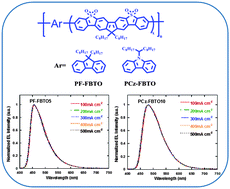Blue light-emitting polymers containing fluorene-based benzothiophene-S,S-dioxide derivatives†
Abstract
Blue light-emitting polymers were synthesized by Suzuki polycondensation via introducing a 9,9-dioctylfluorene bis[2,3-b;6,7-b]benzo-[d]thiophene-S,S-dioxide (FBTO) unit into the polyfluorene or polycarbazole backbone. All the resulting polymers show high fluorescence quantum yield (QPL) and thermal stability. The lowest unoccupied molecular orbital (LUMO) levels reduce gradually, but the highest occupied molecular orbital (HOMO) levels have a little variation upon increasing the amount of FBTO unit in the polymers. The devices based on the polymers exhibited stable electroluminescence spectra with the variation of applied current densities up to 500 mA cm−2. A peak luminous efficiency (LEmax) of 4.05 cd A−1 (corresponding to a maximum external quantum efficiency (EQEmax) of 2.16%) with a luminance of 14 296 cd m−2 was obtained at a turn on voltage of 3.0 V, and still remained 3.0 cd A−1 even at an applied current density of 100 mA cm−2 based on PCz-FBTO10 with a single-layer configuration of ITO/PEDOT:PSS/polymer/CsF/Al. The results indicated that the strategy of introducing an FBTO unit into the polyfluorene or polycarbazole backbone has a potential to achieve efficient blue light emission.


 Please wait while we load your content...
Please wait while we load your content...